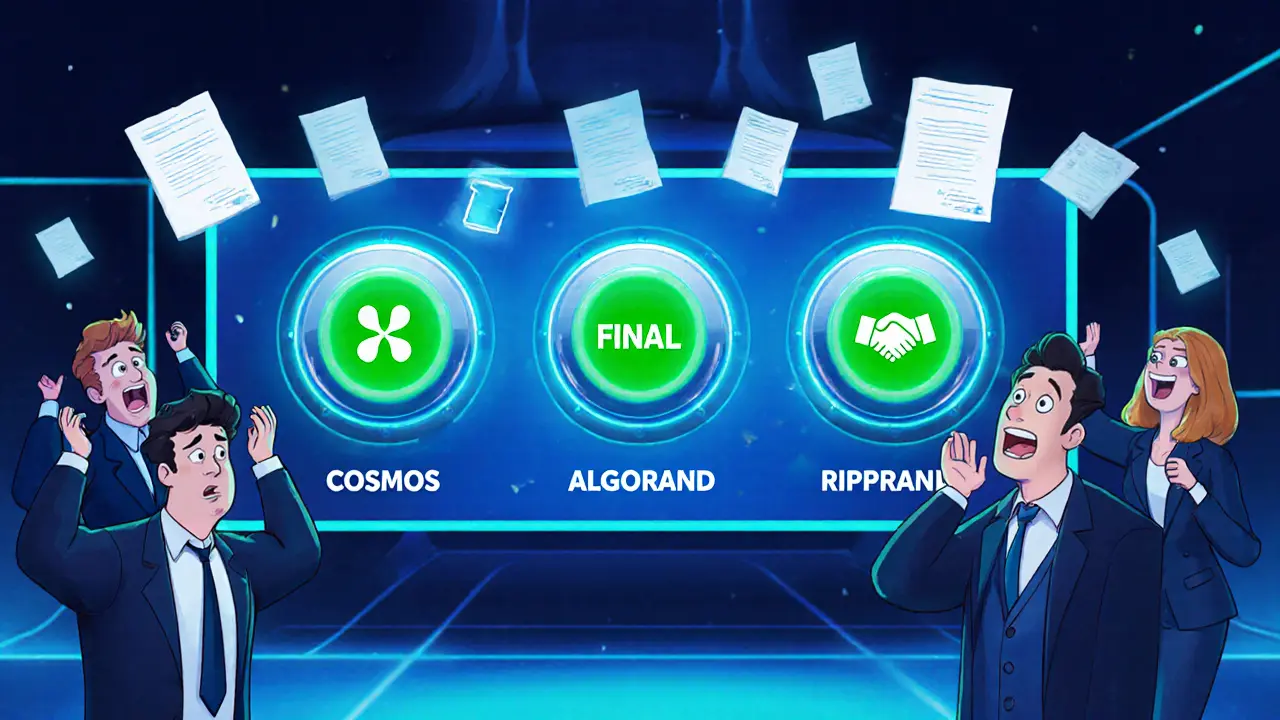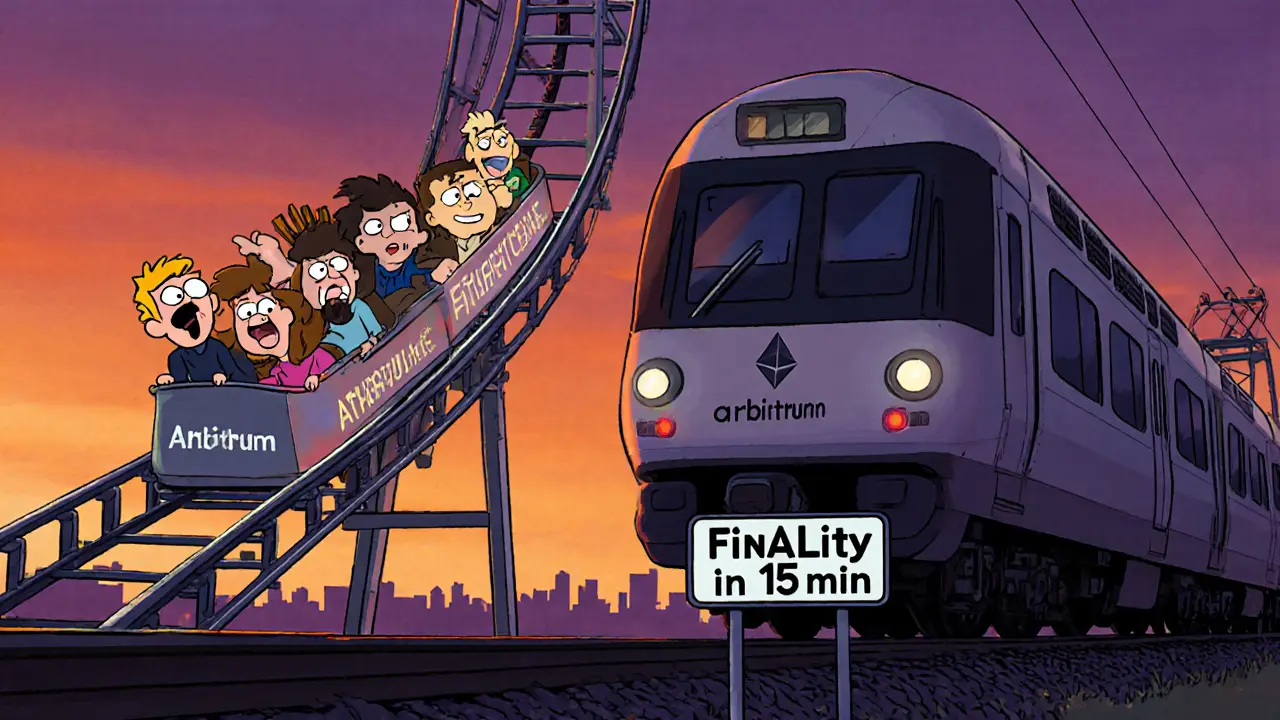When you send crypto, you want to know it’s final. Not just sent. Not just confirmed. But truly done-irreversible, unchangeable, safe. That’s what finality means in blockchain. And not all blockchains deliver it the same way. Some take minutes. Some take seconds. Some are instant. And some? They’re never truly final, just increasingly unlikely to change. If you’re using crypto for payments, trading, DeFi, or enterprise systems, understanding how finality works across different chains isn’t optional-it’s critical.
What Is Blockchain Finality?
Finality is the moment a transaction becomes permanent. No reorgs. No rollback. No 51% attack undoes it. Think of it like signing a legal contract. Once it’s notarized and filed, you can’t just erase it. That’s what users need to trust. But unlike paper contracts, blockchain finality isn’t automatic. It’s built into the consensus rules. And there are four main types: probabilistic, deterministic, economic, and Layer 2 finality.Probabilistic Finality: Bitcoin’s Brick-by-Brick Security
Bitcoin uses probabilistic finality. It doesn’t say "this transaction is final." It says, "the more blocks added on top, the harder it is to undo." Each new block adds another layer of security-like building a wall one brick at a time. After six confirmations (about 60 minutes), most exchanges and services consider a Bitcoin transaction secure enough for high-value transfers. But here’s the catch: it’s never guaranteed. A miner with enough hash power could theoretically rewrite the last six blocks. And guess what? That hash power can be rented. Services like NiceHash let anyone rent Bitcoin’s mining power for a few hours. For smaller chains, that’s a real threat. Bitcoin’s network is massive-over 700 exahashes per second as of 2025-so the cost of attacking it is astronomical. But for chains with less hash power? It’s a different story. Users hate waiting. If you’re paying for coffee, six minutes is fine. If you’re settling a $500,000 trade? You’re sitting there refreshing your wallet, sweating. That’s why Bitcoin isn’t used for fast payments. It’s used for value storage. Its finality isn’t fast. It’s bulletproof.Deterministic Finality: The Circuit Breaker Effect
Now, imagine flipping a switch. Once it’s on, there’s no going back. That’s deterministic finality. Chains like Ripple, Cosmos (Tendermint), and Algorand use this model. As soon as a supermajority of validators (usually two-thirds) agree on a block, it’s final-immediately. No waiting. No confirmations. Just done. This is why these chains are popular for enterprise use. Banks, supply chain systems, and identity platforms need legal certainty. If a payment is recorded, it must be unchangeable under law. Deterministic finality gives that. No ambiguity. No "it might be reversed." The trade-off? Centralization risk. These chains rely on a small set of known validators-often 100 or fewer. That’s faster, but it’s not as decentralized as Bitcoin. If five validators collude? The system breaks. That’s why they’re trusted in permissioned environments, not public DeFi.
Economic Finality: Ethereum’s Staked Trust
Ethereum switched to proof-of-stake in 2022. Its finality mechanism is economic. Validators lock up ETH as collateral. If they act dishonestly-like trying to finalize two conflicting blocks-they lose their stake. That’s the "economic" part. Finality happens when two-thirds of active validators vote on a block. On Ethereum, that takes about 15 minutes after a block is produced. Here’s the nuance: Ethereum has two stages. First, your transaction gets included in a block (12 seconds). Second, it gets finalized (15 minutes later). Many users think "confirmed" means "final." It doesn’t. That’s a common mistake. If you’re using a DApp on Ethereum, and it says "confirmed," you’re not done. You’re still waiting for finality. In May 2023, Ethereum had a finality delay lasting over an hour due to a validator sync issue. It wasn’t a hack. It was a technical glitch. But it showed that even economic finality isn’t flawless. Developers building on Ethereum need to track both block inclusion and finalization separately. That adds complexity. Still, Ethereum’s model strikes a balance. It’s decentralized, secure, and reasonably fast. That’s why it handles over $1 trillion in annual DeFi volume. People trust it enough to risk billions-even with a 15-minute wait.Layer 2 Finality: Borrowed Security
Layer 2s like Arbitrum, Optimism, and zkSync don’t have their own finality. They piggyback on Ethereum. That means if Ethereum takes 15 minutes to finalize, so do your Layer 2 transactions. But here’s the twist: Layer 2s often show "instant" confirmations because they use sequencers to process transactions quickly. You see "confirmed" in your wallet in seconds. But that’s not finality-it’s just a promise from the sequencer. If the sequencer goes offline or tries to cheat, you have to wait for Ethereum to finalize the state root. That can take hours. Many users don’t realize this. They think they’re on a fast chain. They’re not. They’re on a fast layer built on a slower foundation. This creates real risk. If you’re trading on an L2 and the sequencer is compromised, your trade might be reversed-even if your wallet says it’s done. That’s why serious DeFi traders avoid L2s for time-sensitive strategies unless they understand the finality lag.
Which Finality Type Should You Use?
Not all blockchains are built for the same job. Here’s how to choose:- Store value? Go with Bitcoin. Its slow finality is a feature, not a bug. The longer you wait, the safer it gets.
- Need instant payments for business? Use a deterministic chain. Think Cosmos, Algorand, or Polygon’s PoS (with caveats). They’re reliable for enterprise use.
- Using DeFi or smart contracts? Ethereum is your base. But remember: wait for economic finality, not just block inclusion.
- Trading or gaming? Look for instant finality chains. Solana, Avalanche, and near-instant L2s like zkSync Era are better for high-frequency actions.
- Building an app? Know where finality comes from. If you’re on an L2, your security depends on Ethereum. If you’re on a BFT chain, your security depends on validator honesty.
Real-World Mistakes People Make
People assume "confirmed" means "final." It doesn’t. I’ve seen traders lose money because they thought their Arbitrum trade was done after 5 seconds. It wasn’t. The sequencer got stuck. The transaction reverted hours later. Another mistake: ignoring validator sets. If you’re using a chain with only 20 validators, you’re trusting 20 people. That’s fine if you know them. Not fine if you don’t. And then there’s the false sense of speed. Layer 2s make you feel like you’re on a fast chain. But if Ethereum slows down, so do you. You’re not escaping the bottleneck-you’re just hiding behind it.What’s Next for Finality?
The future isn’t one finality model. It’s hybrid systems. New chains are experimenting with combining probabilistic and deterministic elements. Imagine a chain that’s fast like BFT but secure like Bitcoin. Some projects are already testing this. Regulators are watching too. The EU’s MiCA law now requires digital asset providers to disclose finality times. In the U.S., lawmakers are debating whether probabilistic finality meets legal standards for asset ownership. If your crypto isn’t truly final, does it count as owned? The bottom line? Finality isn’t a technical detail. It’s a trust mechanism. Choose your blockchain based on how much certainty you need-not how fast it looks.What does "finality" mean in blockchain?
Finality means a transaction is permanently confirmed and cannot be reversed, even by malicious actors. It’s the point where the blockchain guarantees the transaction is immutable. Different blockchains achieve this in different ways, from waiting for multiple confirmations to requiring validator consensus.
Is Bitcoin transaction final after 6 confirmations?
Six confirmations (about 60 minutes) is the industry standard for high-value Bitcoin transactions because the probability of reversal becomes negligible. But technically, Bitcoin never has absolute finality-it only gets exponentially more secure over time. For most users, six confirmations is safe. For exchanges handling millions, they may wait for 10 or more.
Why does Ethereum take 15 minutes to finalize?
Ethereum uses economic finality under proof-of-stake. After a block is produced every 12 seconds, validators must vote on it. Finality happens when two-thirds of active validators confirm a block, which typically takes 15 minutes. This delay ensures security through economic penalties: validators lose their staked ETH if they act dishonestly.
Are Layer 2 blockchains faster because they have instant finality?
No. Layer 2s like Arbitrum or Optimism show instant confirmations because they use sequencers to process transactions quickly. But their security and finality depend entirely on Ethereum. If Ethereum takes 15 minutes to finalize, so do your L2 transactions. What looks like speed is just a temporary promise-true finality waits for Ethereum’s checkpoint.
Which blockchain has the fastest finality?
Blockchains using deterministic finality like Cosmos (Tendermint), Algorand, and Solana offer near-instant finality-often under 1-3 seconds. These are ideal for trading, gaming, and real-time applications. However, they rely on smaller validator sets, which reduces decentralization compared to Bitcoin or Ethereum.
Can a blockchain with probabilistic finality be hacked?
Yes, but only if an attacker controls more than 50% of the network’s mining power. For Bitcoin, that’s nearly impossible due to its massive hash rate. But for smaller chains with low hash rates, renting mining power makes attacks feasible. That’s why many experts advise against using low-hash-rate chains for anything valuable unless you account for rentable hash power in your risk model.


Comments
Finality isn't a feature it's a tradeoff. Bitcoin's 6 confirmations? That's not security that's patience. You want speed go elsewhere. Stop pretending slow is better.
Ethereum's 15 minute finality is a joke. If your chain needs that long to confirm a transaction you're already dead in the water. Real systems don't wait. They finalize. Period.
L2s are just crypto ponzi schemes with better marketing. You think you're fast but you're just trusting some guy in a server farm. Good luck when the sequencer vanishes
The illusion of finality is the most dangerous myth in blockchain. We confuse statistical improbability with ontological certainty. Bitcoin's model doesn't guarantee truth it merely delays falsehood. And yet we treat it as gospel. This is not engineering this is religion dressed in whitepapers.
People dont get it finality is about trust not tech. If you trust the validators then deterministic is fine. If you dont then bitcoin is your only option. Simple
I want to commend this post for its clarity and depth. This is exactly the kind of thoughtful analysis the crypto space needs more of. Thank you for breaking down such a complex topic with such precision and care.
Ethereum's economic finality is just a fancy way of saying you're betting your money on validators not being lazy. Meanwhile Solana does it in 400ms and no one complains. Why are we still pretending slow is safe?
There's something poetic about Bitcoin's slow finality. It forces you to sit with uncertainty. To wait. To reflect. In a world obsessed with instant gratification maybe we need chains that make us pause. Maybe finality isn't about speed but about presence.
The real tragedy isn't that Layer 2s are slow it's that we've normalized the lie. We tell users their transaction is done when it's not. We give them false confidence. We build DeFi empires on sand and call it innovation. This isn't progress this is performance art for the credulous.
This is such a helpful breakdown! I used to think confirmed = final and got burned hard on Arbitrum. Now I wait for the Ethereum finality tick. Small change huge difference. Thanks for the clarity!
The regulatory implications of probabilistic finality are profound. If legal ownership requires irrevocability then Bitcoin transactions may not satisfy the threshold for asset transfer under common law. This is not a technical issue it is a jurisprudential crisis.
lmao 15 mins for eth finality? that's why no one uses it for payments. even my toaster has faster confirmation than that
I think we're missing the bigger picture. Finality isn't just about speed or security. It's about alignment. Who benefits when a transaction is final? The user? The validator? The protocol? The answer changes everything.
The architecture of trust is the silent architecture of civilization. Bitcoin's probabilistic model mirrors the slow accretion of legal precedent. Ethereum's economic model echoes the binding force of collateralized contracts. Each chain is a cultural artifact reflecting its creators' philosophy of power authority and permanence.
I just want to know if my money is safe. I don't care if it takes 5 seconds or 5 minutes. Just tell me the truth. No hype. No jargon. Just yes or no.
India uses UPI for payments in under 2 seconds. Why are we even debating this? Blockchains are solving problems that dont exist. Real people need speed not philosophy
The 15-minute Ethereum finality window is a systemic vulnerability. Any coordinated attack on validator liveness can delay finality indefinitely. This is not a feature it is a critical failure mode. And yet we continue to build trillions in value atop it.
Oh wow so Bitcoin is slow and safe and Ethereum is slow and expensive and L2s are just lies? And Solana is the only one that works? Cool. So we're all just waiting for the next chain to come along and do the same thing better? How original.
Honestly I just use whatever feels fastest. If my wallet says done I move on. I trust the devs to handle the backend mess. If it breaks I'll complain then. Until then I'm chill.
The entire blockchain industry is a CIA psyop. Finality is a lie. They control the validators. They control the miners. They control the narrative. The real finality is in your bank account. The rest is theater. Wake up.